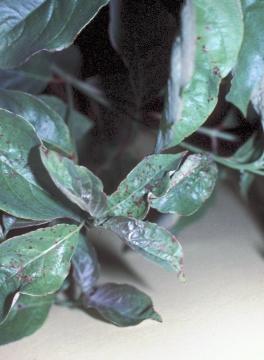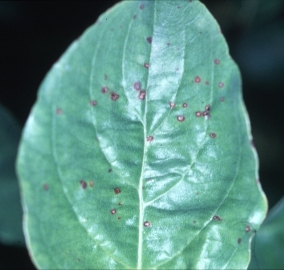Spot Anthracnose on Dogwood
Causal Agent
Elsinoe corni
Hosts
Although all flowering dogwoods are susceptible to this disease, white cultivars are usually affected most.
 Symptoms
Symptoms
During periods of wet, humid weather in late winter to early spring, spores produced on infected twigs and other tissues are spread by windblown rain or splashing water. Spots on the bracts and leaves are small (usually 1/16 to 1/25 inch diameter), circular to elongated, with a reddish-purple margin and dusty yellow to tan center. Spots developing on young leaves may have a yellow halo while those on the mature leaves do not. Numerous spots may coalesce into large blighted areas. On young shoots and berries, the disease appears as elongated lesions with purple margins. Badly diseased bracts and sometimes leaves are shed by the tree. As with other foliar tree diseases, spot anthracnose rarely directly kills a tree, although repeated early defoliation may reduce flower bud number and possibly increase plant sensitivity to moisture or temperature extremes. Frequent rains or extended periods of high humidity are needed for spot anthracnose development. With dry weather during flower bud swell and bloom, symptoms are rarely seen on the bracts. If spotting does not appear on the bracts, the disease may not be severe on the leaves.
 Control
Control
Spot anthracnose is much worse on flowering dogwoods growing in full sun than in shade. Planting new dogwoods especially early flowering cultivars, on shaded sites often will prevent disease development. In landscapes, applying a fungicide every 7 to 10 days starting at bud bread through bract fall will control spot anthracnose. However, chemical treatment is rarely needed in Oklahoma. Please contact your local county extension office for the most current information.


